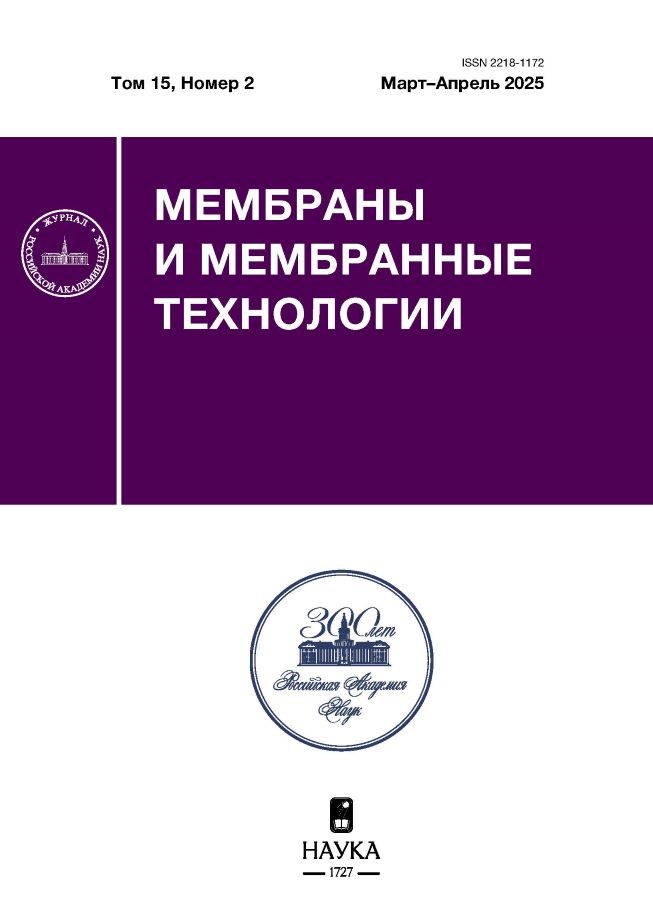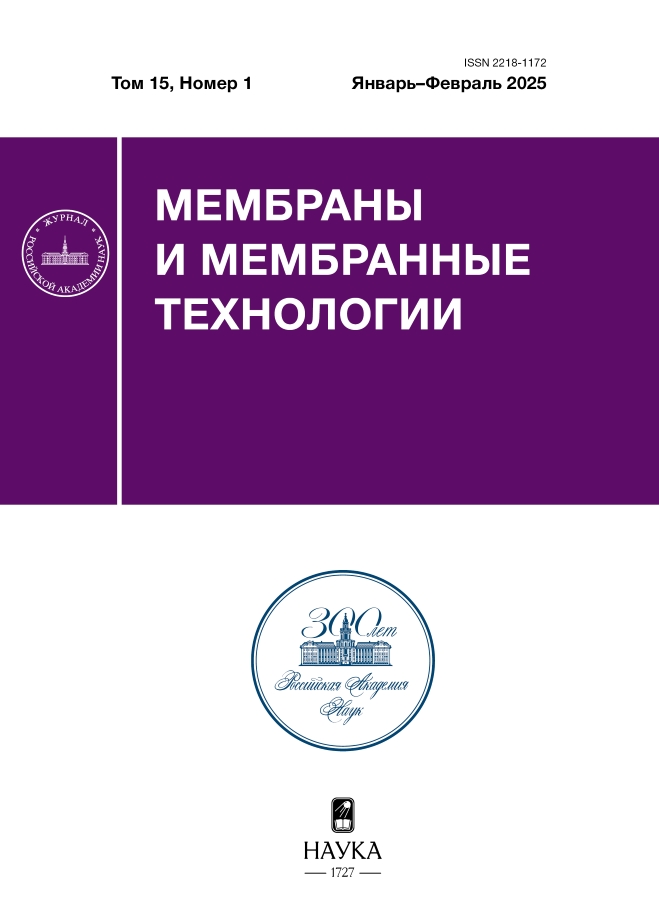Стабильность полимерных композиционных мембран на основе фторсодержащих полисилоксанов в условиях тропического климата
- Авторы: Рохманка Т.Н.1, Дмитриева Е.С.1, Анохина Т.С.1, Костина Ю.В.1, Грушевенко Е.А.1, Hoang T.2
-
Учреждения:
- Институт нефтехимического синтеза имени А.В. Топчиева РАН
- Southern Branch of Joint Vietnam–Russia Tropical Science and Technology Research Center
- Выпуск: Том 15, № 1 (2025)
- Страницы: 44-62
- Раздел: Статьи
- URL: https://ruspoj.com/2218-1172/article/view/685292
- DOI: https://doi.org/10.31857/S2218117225010044
- EDN: https://elibrary.ru/LAODAW
- ID: 685292
Цитировать
Полный текст
Аннотация
Одной из ключевых задач мембранной технологии является повышение устойчивости к засорению (фаулингу) и деградации поверхности мембран. В данной работе исследована стабильность свойств селективного слоя на основе фторсодержащих полисилоксанов при экспозиции в течение 6 месяцев на климатических площадках Вьетнама. В работе исследованы три композиционные мембраны на микрофильтрационной подложке МФФК-1 с селективными слоями: 1) полидециметилсилоксана (С10), 2) сополимера С10 и полисилоксана с трифторалкилакрилатной боковой группой (С10–F3), 3) сополимера С10 и полисилоксана с перфтороктильной боковой группой (С10–ПФО). Проанализировано сравнение изменения состава и свойств поверхности селективного слоя, а также газотранспортных свойств до и после экспозиции на испытательных площадках. Показано, что для мембран на основе фторсодержащих полисилоксанов (С10–F3 и С10–ПФО) наблюдается меньшее засорение и деградация полимера селективного слоя. Для образца С10 отмечено разрушение боковых алкильных фрагментов и повышение концентрации атомов кислорода на поверхности селективного слоя, в том числе за счет осаждения микроводорослей. Мембраны С10–F3 продемонстрировали наибольшую стабильность газопроницаемости по СО2 и N2 (изменение не более 10%) и наименьшую окислительную деструкцию.
Полный текст
Об авторах
Т. Н. Рохманка
Институт нефтехимического синтеза имени А.В. Топчиева РАН
Email: evgrushevenko@ips.ac.ru
Россия, Ленинский пр., 29, Москва, 119991
Е. С. Дмитриева
Институт нефтехимического синтеза имени А.В. Топчиева РАН
Email: evgrushevenko@ips.ac.ru
Россия, Ленинский пр., 29, Москва, 119991
Т. С. Анохина
Институт нефтехимического синтеза имени А.В. Топчиева РАН
Email: evgrushevenko@ips.ac.ru
Россия, Ленинский пр., 29, Москва, 119991
Ю. В. Костина
Институт нефтехимического синтеза имени А.В. Топчиева РАН
Email: evgrushevenko@ips.ac.ru
Россия, Ленинский пр., 29, Москва, 119991
Е. А. Грушевенко
Институт нефтехимического синтеза имени А.В. Топчиева РАН
Автор, ответственный за переписку.
Email: evgrushevenko@ips.ac.ru
Россия, Ленинский пр., 29, Москва, 119991
Thanh Long Hoang
Southern Branch of Joint Vietnam–Russia Tropical Science and Technology Research Center
Email: evgrushevenko@ips.ac.ru
Вьетнам, Ho Chi Minh City 740500
Список литературы
- Huang W., Zhu Y., Wang L., Lv W., Dong B., Zhou W. Reversible and irreversible membrane fouling in hollow-fiber UF membranes filtering surface water: effects of ozone/powdered activated carbon treatment // RSC advances. 2021. V. 11 (17). P. 10323–10335.
- Santos A.V., Lin A.R.A., Amaral M.C.S., Oliveira S.M.A.C. Improving control of membrane fouling on membrane bioreactors: A data-driven approach // Chemical Engineering Journal. 2021. V. 426. 131291.
- Zhang R., Liu Y., He M., Su Y., Zhao X., Elimelech M., Jiang Z. Antifouling membranes for sustainable water purification: strategies and mechanisms // Chemical Society Reviews. 2016. V. 45 (21). P. 5888–5924.
- Rana D., Matsuura T. Surface modifications for antifouling membranes // Chemical reviews. 2010. V. 110 (4). P. 2448–2471.
- Magin C.M., Cooper S.P., Brennan A.B. Non-toxic antifouling strategies // Materials today. 2010. V. 13 (4). P. 36–44.
- Wang F., Zhang H., Yu B., Wang S., Shen Y., Cong H. Review of the research on anti-protein fouling coatings material // Progress in Organic Coatings. 2020. V. 147. 105860.
- Uwaezuoke O.J., Kumar P., Pillay V., Choonara Y.E. Fouling in ocular devices: implications for drug delivery, bioactive surface immobilization, and biomaterial design // Drug Delivery and Translational Research. 2021. V. 11 (5). P. 1903–1923.
- Maan A.M.C. et al. Recent developments and practical feasibility of polymer‐based antifouling coatings // Advanced functional materials. 2020. V. 30 (32). 2000936.
- Apel P.Yu., Velizarov S., Volkov A.V., Eliseeva T.V., Nikonenko V.V., Parshina A.V., Pismenskaya N.D., Popov K.I., Yaroslavtsev A.B. Fouling and Membrane Degradation in Electromembrane and Baromembrane Processes // Membranes and Membrane Technologies. 2022. V. 4. P. 69–92.
- Drews A. Membrane fouling in membrane bioreactors–Characterisation, contradictions, cause and cures // Journal of membrane science. 2010. V. 363 (1–2). P. 1–28.
- Volkov V., Borisov I., Golubev G., Vasilevsky V., Matveev D., Bondarenko G., Volkov A. Sorption-assisted thermopervaporation method for organics recovery from ABE fermentation broth // Journal of Chemical Technology & Biotechnology. 2020. V. 95 (1). P. 40–51.
- Da-Silva-Correa L.H., Smith H., Thibodeau M.C., Welsh B., Buckley H.L. The application of non-oxidizing biocides to prevent biofouling in reverse osmosis polyamide membrane systems: a review // AQUA–Water Infrastructure, Ecosystems and Society. 2022. V. 71 (2). P. 261–292.
- Daly S., Allen A., Koutsos V., Semião A.J. Influence of organic fouling layer characteristics and osmotic backwashing conditions on cleaning efficiency of RO membranes // Journal of Membrane Science. 2020. V. 616. 118604.
- Rajendran D.S., Devi E.G., Subikshaa V.S., Sethi P., Patil A., Chakraborty A., Kumar V.V. Recent advances in various cleaning strategies to control membrane fouling: a comprehensive review // Clean Technologies and Environmental Policy. 2024. P. 1–16.
- Zhan M., Gwak G., Kim D.I., Park K., Hong S. Quantitative analysis of the irreversible membrane fouling of forward osmosis during wastewater reclamation: Correlation with the modified fouling index // Journal of Membrane Science. 2020. V. 597. 117757.
- Zhao S., Liao Z., Fane A., Li J., Tang C., Zheng C., Kong L. Engineering antifouling reverse osmosis membranes: A review // Desalination. 2021. V. 499. 114857.
- Khan R. Enhancing the pervaporation performance of PEBA/PVDF membrane by incorporating MAF-6 for the separation of phenol from its aqueous solution // Separation and Purification Technology. 2021. V. 256. 117804.
- Liu W., Lin H., Wang J., Han Q., Liu F. Polytetrafluoroethylene (PTFE) hollow fibers modified by hydrophilic crosslinking network (HCN) for robust resistance to fouling and harsh chemical cleaning // Journal of Membrane Science. 2021. V. 630. 119301.
- Salimi P., Aroujalian A., Iranshahi D. Graft copolymerization of zwitterionic monomer on the polyethersulfone membrane surface by corona air plasma for separation of oily wastewater // Separation and Purification Technology. 2021. V. 258. 117939.
- Kim D.S., Kang J.S., Lee Y.M. Microfiltration of activated sludge using modified PVC membranes: Effect of pulsing on flux recovery // Separation Science and technology. 2003. V. 38 (3). P. 591–612.
- Yang Q., Xu Z.K., Dai Z.W., Wang J.L., Ulbricht M. Surface modification of polypropylene microporous membranes with a novel glycopolymer // Chemistry of Materials. 2005. V. 17 (11). P. 3050–3058.
- Iwata H., Ivanchenko M.I., Miyaki Y. Preparation of anti‐oil stained membrane by grafting polyethylene glycol macromer onto polysulfone membrane // Journal of Applied Polymer Science. 1994. V. 54 (1). P. 125–128.
- Crivello J.Y., Belfort G., Yamagishi H. Chem. Abstr. 1996, 124, 148194r; U.S. Patent 5,468,390, 1995.
- Kilduff J.E., Mattaraj S., Pieracci J.P., Belfort G. Photochemical modification of poly (ether sulfone) and sulfonated poly (sulfone) nanofiltration membranes for control of fouling by natural organic matter // Desalination. 2000. V. 132 (1–3). P. 133–142.
- Gancarz I., Pozniak G., Bryjak J., Bryjak M., Kunicki J. Plasma modification of polymer membranes. 2007.
- Kim K.S., Lee K.H., Cho K., Park C.E. Surface modification of polysulfone ultrafiltration membrane by oxygen plasma treatment // Journal of Membrane Science. 2002. V. 199 (1–2). P. 135–145.
- Lejars M., Margaillan A., Bressy C. Fouling release coatings: a nontoxic alternative to biocidal antifouling coatings // Chemical reviews. 2012. V. 112 (8). P. 4347–4390.
- Eduok U., Faye O., Szpunar J. Recent developments and applications of protective silicone coatings: A review of PDMS functional materials // Progress in Organic Coatings. 2017. V. 111. P. 124–163.
- Guo W., Ngo H.H., Li J. A mini-review on membrane fouling // Bioresource technology. 2012. V. 122. P. 27–34.
- Li B. Synthesis of POSS-containing fluorosilicone block copolym ers via RAFT polymerization for application as non-wetting coating materials // Progress in Organic Coatings. 2015. V. 78. P. 188–199.
- Liu Y. Synthesis and characterization of a novel fluorosilicone resin based on trifluoropropylalkoxylsilane // Materials Chemistry and Physics. 2019. V. 224. P. 40–46.
- Cornelius D.J., Monroe C.M. The unique properties of silicone and fluorosilicone elastomers // Polymer Engineering & Science. 1985. V. 25 (8). P. 467–473.
- Peng H. Synthesis and application of fluorine-containing polymers with low surface energy // Polymer Reviews. 2019. V. 59 (4). P. 739–757.
- Zhou C., Shen D., Chai C., Shi B., Zhu B., Wang G. A low dielectric constant material synergized by calix[4]arene and benzocyclobutene units // Journal of Materials Chemistry C. 2023. V. 11 (31). P. 10509–10519.
- Rubinsztajn C., Chojnowski J., Mizerska U. Tris(pentafluorophenyl)borane-catalyzed Hydride Transfer Reactions in Polysiloxane Chemistry–Piers–Rubinsztajn Reaction and Related Processes // Molecules. 2023. V. 28 (16). 5941.
- Zhang S., Zhang Y., Wang Z., Qiao W. Synthesis and characterizations of polystyrene materials with low dielectric constant and low dielectric loss at high frequency // Journal of Applied Polymer Science. 2023. V. 140 (27). e54012.
- Chen S., He T., Li Y., Li X., Zhuang Y., Wang X., Liu Y., Liu X. Significantly reduced intrinsic dielectric constant and loss of nano-silica by direct fluorination // Ceramics International. 2023. V. 49 (14). P. 22816–22825.
- Owen M.J. Surface tension of polytrifluoropropylmethylsiloxane // Journal of Applied Polymer Science. 1988. V. 35 (4). P. 895–901.
- Graham P. Fluoropolymers with very low surface energy characteristics // Journal of Fluorine Chemistry. 2000. V. 104 (1). P. 29–36.
- Grushevenko E.A. Effect of OH-Group Introduction on Gas and Liquid Separation Properties of Polydecylmethylsiloxane // Polymers. 2023. V. 15 (3). P. 723.
- Lyadov A. Effects of the Tropical Climate of Vietnam on the Properties of Synthetic Greases with Urea Thickeners // Petroleum Chemistry. 2023. V. 63 (8). P. 1002–1008.
- Borisov I.L., Grushevenko E.A., Anokhina T.S., Bakhtin D.S., Levin I.S., Bondarenko G.N., Volkov A.V. Influence of side chains assembly on the structure and transport properties of comb-like polysiloxanes in hydrocarbon separation // Materials Today Chemistry. 2021. V. 22. 100598.
- Noi P.T., Kappas M., Degener J. Estimating daily maximum and minimum land air surface temperature using MODIS land surface temperature data and ground truth data in Northern Vietnam // Remote Sensing. 2016. V. 8 (12). P. 1002.
- Zhu H., Li X., Pan Y., Liu G., Wu H., Jiang M., Jin W. Fluorinated PDMS Membrane with Anti-biofouling Property for in-situ Biobutanol Recovery from Fermentation-Pervaporation Coupled Process // J. Membr. Sci. 2020. V. 609. 118225.
- Zheng X. Fabrication of UV-curable fluorosilicone coatings with impressive hydrophobicity and solvent resistance // Progress in Organic Coatings. 2020. V. 144. 105633.
Дополнительные файлы






















